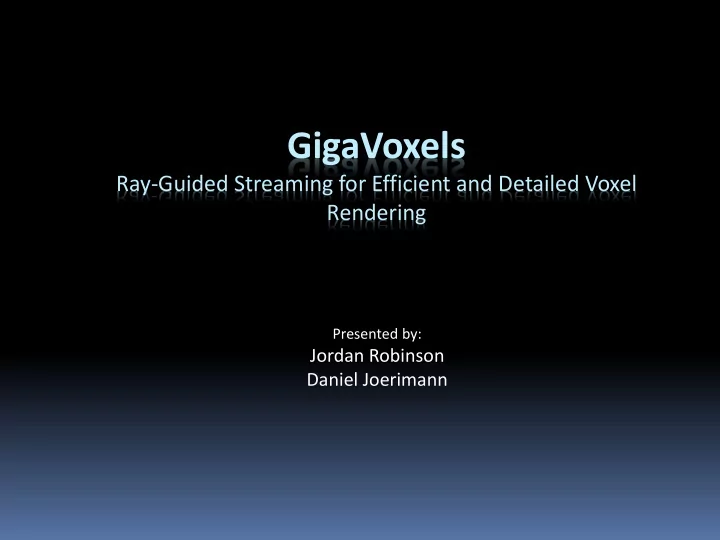

GigaVoxels Ray-Guided Streaming for Efficient and Detailed Voxel Rendering Presented by: Jordan Robinson Daniel Joerimann
Outline Motivation GPU Architecture / Pipeline Previous work Support structure / Space partitioning Rendering Tree updating on the GPU Results
Motivation Why Voxels? Visualizing scientific data / 3D scans Easy to manipulate Good for pseudo-surfaces ... but hard to render very large data sets with interactive rates (Real time)
GPU Architecture / Pipeline
Previous Work GPU Gems 2: Octree Textures on the GPU by Lefebvre, Hornus, Neyret 2005 Rendering Fur With Three Dimensional Textures by Kajiya and Kay 1989 On-the-fly Point Clouds through Histogram Pyramids by Ziegler, Tevs, Theobalt, Seidel 2006 High-Quality Pre-Integrated Volume Rendering Using Hardware-Accelerated Pixel Shading by Engel, Kraus, Ertl 2001
Space partitioning Sparse distribution of voxels Voxels have to be organized Accelerates Ray Traversal Spatial N 3 – Trees Typically N = 2 Octree
Support structure Split into tree and bricks Node: Corresponds to a node in the N 3 tree Brick: Contains the Voxel data
Support structure: Brick Bricks are stored in a large shared 3D – Texture (Brick pool) Voxel-grid of size M 3 (usually M =32) 3D-Mip-Mapped
Support structure: Memory layout Tree-Nodes and bricks are stored in 3D Textures (Node Pool and Brick Pool) Nodes can point to child nodes and a corresponding brick
Support structure: Node Texel Contains (64 bits): 3D Pointer (X,Y,Z) to the next level in the tree (N 3 child nodes) Constant Color or Brick Pointer Flag indicating whether it is a leaf node Flag indicating the node type (Constant Color or Brick pointer)
Rendering 1. Rendering of a proxy geometry to generate rays 2. Tracing the rays into the tree (Up to the needed LOD) 3. Shade pixel 4. Tree updates
Rendering: Proxy geometry Needed to initialize (create) rays Either a bounding box or some approximate geometry of the volume Render front faces and back faces defining the view rays into a texture
Rendering: Tracing rays Render the flat texture (from the step before) Walk the tree / bricks for every pixel in the fragment shader DDA could be used but is inefficient on the GPU Iterative descent is faster due to the GPU cache
Rendering: High Quality Filtering The filtering quality for the previous ray traversal method could be improved 3 MIP-Map levels are used to filter
Pixel shading Accumulated color and opacity values Phase function Pre-integrated transfer function Using the density gradient as the normal for pseudo-Phong shading
Tree updates / Memory management The entire tree and brick pool are usually too large to fit into the GPU memory Interrupting and updating Multiple passes Mark pixels with insufficient data 1. Interrupt 2. Load missing data 3. Continue Early-Z and Z-Cull prevents pixels with terminated rays from being overdrawn
Advanced Algorithm Interrupting and updating is too slow: Requires lots of CPU interaction (CPU-GPU bandwidth is limited) Try to keep all needed data available in the GPU’s memory => Render one frame in one step Every node and brick has a Timestamp in the CPU’s memory Replaces nodes and bricks by LRU
Advanced Algorithm CPU: while (true) Render image (using the GPU) Get list of accessed/needed nodes from the GPU Reset timestamp of accessed nodes Expand or collapses nodes Update GPU memory with needed nodes (LRU) GPU: Fragment shader First pass: Trace ray if LOD not available Pick next higher available level in Mip-map Shade pixel Keep a list of accessed nodes / Mip-map levels in result textures Second pass: Compress accessed/needed data
Advanced Algorithm Node list is stored in multiple render targets (MRTs) RGBA32 = 4 x 32 bit One node pointer uses 32 bits One channel per node pointer Can store up to 12 node id’s per pixel using 3 MRTs
Advanced Algorithm: Compression Spatial node coherence Normally 3 MRTs would not be enough Neighboring rays traverse similar nodes Group in 2x2 grid
Advanced Algorithm: Compression Temporal coherence: Used nodes are similar between subsequent frames FIFO (48 items) 48-element window is shifted after each subsequent frame First frame: push up to 48 nodes into the FIFO Second frame: push up to 96 nodes into the FIFO Push node 5 Push node 1 1 2 3 4 5 Push node 6 Push node 2 3 4 5 6 1 2 … Push node 4 1 2 3 4
Advanced Algorithm: Compression Compaction of update information Preprocess update information before compaction Use mask to remove redundant node selections Compaction step by using Histogram pyramids covered in: http://www.mpi-inf.mpg.de/~gziegler/gpu_pointlist/paper17_gpu_pointclouds.pdf Final step Fit as much as possible in one RGBA32 texture (4 Nodes per pixel) Postpone to next frame if the limit is exceeded Usually 2-3 nodes per pixel are selected
Results Explicit volume (trabecular bone) 8192 3 Voxels 20 – 40 Fps (Mip-mapping enabled) 60 Fps (Mip-mapping disabled) System: Core2 bi-core E6600 at 2.4 GHz & NVIDIA 8800 GTS 512MB
Results Hypertextured bunny 1024 3 Voxels 20fps System: Core2 bi-core E6600 at 2.4 GHz & NVIDIA 8800 GTS 512MB
Video
Questions?
Recommend
More recommend